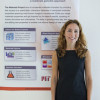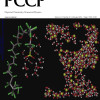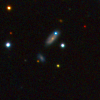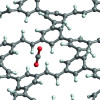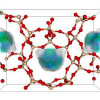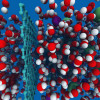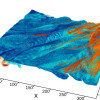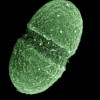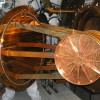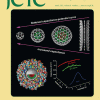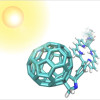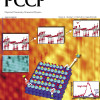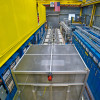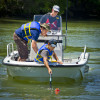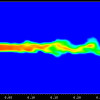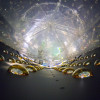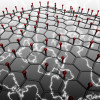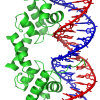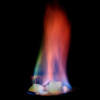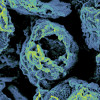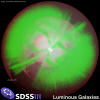Science News
NERSC Helps Develop Next-Gen Batteries
As part of DOE's new Batteries and Energy Storage Hub, NERSC resources will be used to predict the properties of electrolytes. When JCESR is up and running, collaborators will be able to combine these results with the existing Materials Project database to get a complete scope of battery components. Read More »
Modeling Feat Sheds Light on Protein Channel's Function
Using supercomputers at NERSC, chemists have simulated the biological function of the Sec translocon, which allows specific proteins to pass through membranes. The feat required bridging timescales from the realm of nanoseconds up to full minutes, exceeding earlier simulation efforts by more than 6 orders of magnitude. Read More »
The Path a Proton Takes Through a Fuel Cell Membrane
Experts believe that fuel cells may someday serve as clean energy conversion devices for transportation and other applications, but there are still some design issues that engineers need to sort out before this can happen. One challenge is to develop an inexpensive and robust polymer membrane that effectively conducts protons. In a step toward achieving that goal, researchers are running computer simulations at NERSC to understand how protons move through different polymer membranes. Read More »
Supernovae of the Same Brightness, Cut From Vastly Different Cosmic Cloth
Palomar Transient Factory team presented the first-ever direct observations of a Type 1a supernova progenitor system. Astronomers have collected evidence indicating that the system, called PTF 11kx, contains a red giant star. They also show that the system previously underwent at least one much smaller nova eruption before it ended its life in a destructive supernova. The event was initially detected by the PTF Real-Time Detection pipeline at NERSC. Read More »
Haverford College Researchers Create Carbon Dioxide-Separating Polymer
Using supercomputers at NERSC, researchers from Haverford College have come up with a new type of two-dimensional polymer, PG-ES1, which allows, in theory, for highly efficient separation of carbon dioxide from the exhausts of power plants. Read More »
New Computer Model Pinpoints Prime Materials for Carbon Capture
With help from NERSC's Petascale Initiative and DIRAC, researchers developed computer model to screen solid materials for cost-effectively capturing carbon emissions from fossil fuel-burning power plants. The new model shows that the parasitic energy costs of carbon capture could be reduced by 30 percent with the use of more efficient materials. Read More »
A new approach to water desalination
MIT researchers found that graphene sheets with precisely controlled pores have potential to purify water more efficiently than existing methods. Read More »
A new approach to water desalination
MIT researchers found that graphene sheets with precisely controlled pores have potential to purify water more efficiently than existing methods. Read More »
Sifting Through a Trillion Electrons
Astrophysicists using NERSC's Hopper system generated a 3D trillion-particle magnetic reconnection dataset, where each time-step amounted to a massive 32 terabyte file. With specialized tools developed by Berkeley Lab researchers, the scientists queried the dataset in 3 seconds and visualized it. This is the first-time a dataset of this magnitude has been queried and visualized so quickly. Read More »
Scientists Help Define the Healthy Human Microbiome
The human microbiome’s exact function, good and bad, is poorly understood. But, that could all change now that the normal microbial make-up of healthy humans has been mapped for the first time. Read More »
Using NERSC Systems, Physicists Close In on a Rare-Particle Decay Process
With help from supercomputers at NERSC, the Enriched Xenon Observatory experiment (EXO-200) has placed the most stringent constraints yet on the nature of a process called neutrinoless double beta decay. In doing so, the physicists have narrowed down the range of possible masses for the neutrino. Read More »
Why Onion-Like Carbons Make High-Energy Supercapacitors
The two most important electrical storage technologies are batteries and capacitors. Batteries can store a lot of energy, but have slow charge and discharge rates. Capacitors generally store less energy but have very fast (nearly instant) charge and discharge rates, and last longer than rechargeable batteries. Developing technologies that combine the optimal characteristics of both will require a detailed understanding of how these devices work at the molecular level. And researchers used supercomputers at NERSC to do just that. Read More »
Learning From Photosynthesis to Create Electricity
Inspired by plants, scientists have created a light-harvesting material that can turn sunlight into chemical energy. However, creating a stable form of the material for large-scale usage has proved difficult. Read More »
Turning Water into Hydrogen Fuel
To do its job, the popular catalyst titanium dioxide often needs an even layer of hydroxyl groups across its surface; thanks to a new method by scientists at PNNL, the catalyst is now getting it. Read More »
New Accelerator Will Study Steps on the Path to Fusion Power
The Neutralized Drift Compression Experiment, NDCX-II has recently marked successful completion. Designed with the aid of computer simulations executed at NERSC, the accelerator was created to study warm dense matter, an important research field in itself and particularly relevant to nuclear fusion. NDCX-II will test a variety of technologies in preparation for a new generation of power plants on Earth that will mimic the engines of the stars. Read More »
Floating Robots Track Water Flow, Stream Data via Smartphones
To understand how water flows through the Sacramento-San Joaquin Delta, 100 mobile sensors were placed into the Sacramento River on May 9 to make critical measurements every few seconds. Once collected, this data is transmitted to NERSC for assimilation and analysis. Read More »
New Computer Codes Unlock the Secrets of Cleaner Burning Coal
Researchers supported by the Department of Energy are investigating relatively "clean" methods for extracting energy from coal—like gasification. Using NERSC systems, a scientist from the University of Utah has developed tools to model and validate the complex processes of coal gasification Read More »
Researchers Discover a New Kind of Neutrino Transformation
Some unprecedentedly precise measurements from the Daya Bay Neutrino Experiment are revealing how electron antineutrinos “oscillate” into different flavors as they travel. This finding may eventually solve the riddle of why there is far more ordinary matter than antimatter in the universe today. Read More »
A Roadmap for Engineering Piezoelectricity in Graphene
With the help of supercomputers at the Department of Energy’s NERSC, researchers at Stanford University have uncovered yet another hidden talent of graphene—with a little chemical doping, it can be transformed into a controllable piezoelectric material. This discovery could lead to a wide variety of nanoscale devices from electronics and photonics to chemical sensing and high frequency acoustics. Read More »
New Mathematical Method Reveals Where Genes Switch On or Off
Developmental biologists using computing resources at NERSC, have taken a new mathematical method used in signal processing and applied it to biochemistry, using it to reveal the atomic-level details of protein–DNA interactions with unprecedented accuracy. They hope this method, called “compressed sensing,” will speed up research into where genes are turned on and off, and they expect it to have applications in many other scientific domains as well. Read More »
The Great Gas Hydrate Escape
For some time, researchers have explored flammable ice for low-carbon or alternative fuel or as a place to store carbon dioxide. Now, a computer analysis of the ice and gas compound, known as a gas hydrate, reveals key details of its structure. This work could enlighten alternative fuel production and carbon dioxide storage. Read More »
Bubbles Help Break Energy Storage Record for Lithium Air-Batteries
Using supercomputers at NERSC and microscopy, a team of researchers from the Pacific Northwest National Laboratory and Princeton University recently built a novel graphene membrane that could produce a lithium-air batter with the highest-energy capacity to date. Read More »
Calculating What’s in the Universe from the Biggest Color 3-D Map
Using NERSC systems, Berkeley Lab scientists and their Sloan Digital Sky Survey colleagues have produced the biggest 3D color map of the universe ever. The team also achieved the most accurate calculation yet of how matter clumps together – from a time when the universe was only half its present age until now. Read More »






